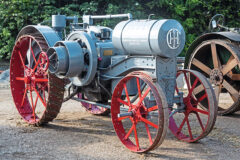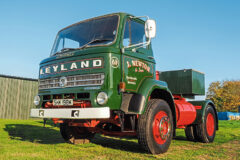Eventful times for HMS Albion
Posted by Chris Graham on 16th August 2023
Neil McCart recounts two eventful years in the career of HMS Albion, after her conversion from an aircraft carrier to a commando carrier.

HMS Albion departing Portsmouth for the Far East Station on 3rd November, 1962.
The year 1962 was a landmark one in the 19-year career of the light fleet aircraft carrier HMS Albion. She catapulted her last jet aircraft in December 1960, and had spent 18 months in dockyard hands at Portsmouth, being converted from an aircraft carrier to a commando carrier. On 1st August 1962 she was recommissioned for her very eventful first commission in her new role.
During the period she was in dockyard hands, her catapults and arrester wires were removed and additional messdecks were provided for the Commando Groups which would be embarked. The gun sponsons on both sides of the ship were converted to carry four LCAs. During the second week of August 1962, Albion put to sea for the first time in 18 months to carry out post-refit trials and a work-up, for which 41 Commando Group, Royal Marines, were embarked in Plymouth Sound and landed in Dorset to ‘assault’ the Purbeck Hills.

HMS Albion entering Aden with Wessex helicopters lined up on her flight deck.
She steamed down the Channel to the Lizard area, where she embarked her two helicopter squadrons, 845 with its Westland Wessex HA1s, and 846 with Westland Whirlwind HAS-7s. On 3rd November 1962 the ship sailed for one of the last long Foreign Service commissions East of Suez.
As Albion steamed through the Mediterranean she took part in Exercise Sandfly, landing 41 Commando by Wessex helicopters then, on 20th November, she arrived at Aden, where she was secured astern of her sister Bulwark. The next five days were spent transferring stores and 41 Commando were exchanged for 40 Commando.

HMS Albion going alongside upon her arrival at Gibraltar, three days after she left Portsmouth.
Finally, on Monday 26th November 1962, with the changeover completed, Bulwark left Aden and the following signals were exchanged: Bulwark: ‘Good luck. Over to you. Happy landings. You’ve got the weight.’ Albion: ‘We are grateful for the spadework you have done. A good trip and a happy homecoming be it fog, mist, falling snow or heavy rain.’
In the event Bulwark returned to the coldest winter in the UK since 1881, while Albion was to hold the weight of the Indonesian Confrontation for 12 months. Unfortunately, while Albion was manoeuvring to leave Aden Harbour, her attendant tug, Sir Tom, capsized and sank with the loss of two lives. From Aden, Albion steamed south to the northern coast of Kenya, where, off Malindi, there was a full-scale landing exercise, during which the squadron helicopters landed 40 Commando to the north of Malindi. Next day Albion herself steamed south to Mombasa.
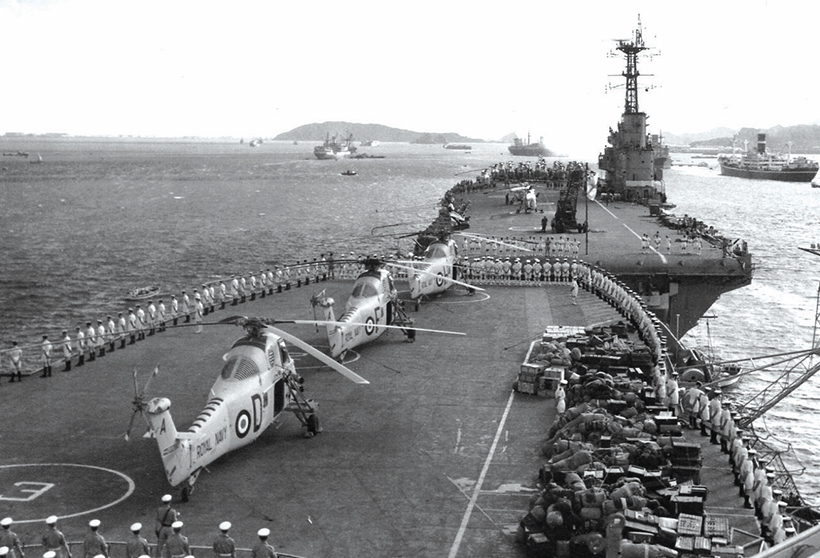
HMS Albion manoeuvring in Aden harbour to secure astern of HMS Bulwark.
On 2 December Albion left Mombasa to make a routine passage across the Indian Ocean to the naval base at Singapore. However, just after midnight on 9th December a signal was received from the C-in-C FES, which read: ‘Proceed with all dispatch Singapore’. That night the whole ship vibrated; down below in the engine and boiler rooms, the main propulsion machinery was pushed to its limits as Albion steamed flat out across the Indian Ocean.
The emergency was an armed revolt, which had broken out at 02:00 on 8th December, in the Sultanate of Brunei, a small self-governing state on the north coast of the island of Borneo, resulting in attacks on police stations throughout the territory. It was, in fact, the first stage of the Indonesian Confrontation, and the ferocity of the rebellion took the authorities by surprise.
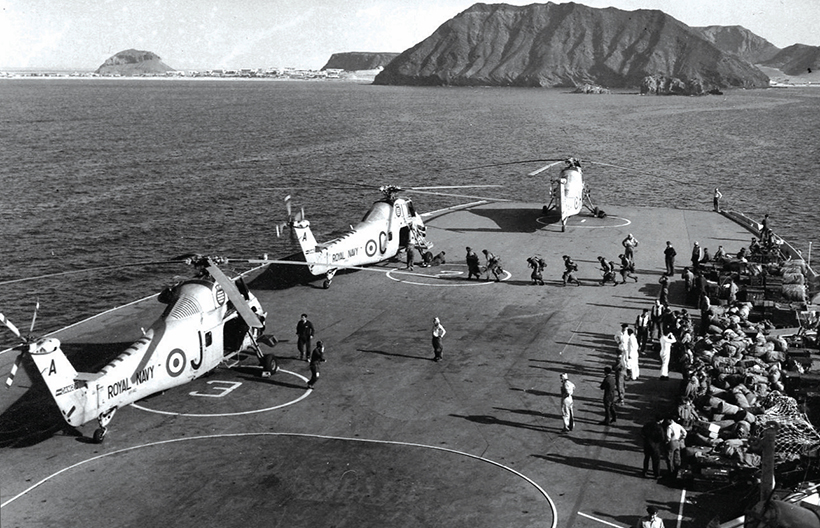
Sailors aboard Albion prepare for a land exercise off Little Aden.
The political reasons behind the revolt were complicated and dated back to the 19th century, when the Netherlands and Britain carved up the island of Borneo, creating borders which had never been recognised by nationalists in the large Netherlands-administered area of Kalimantan. This had come to a head with the forthcoming merger of Borneo and Brunei with Malaya and Singapore, creating Malaysia, which was seen by Indonesia as an extension of British colonialism.
As Albion neared Singapore a further signal was received which stated: ‘Situation in Brunei still obscure, but rebels are more numerous than at first supposed. They appear to hold Siria Oilfield area and coastal strip between Miri and Brunei. Albion, with 40 Cdo, has been diverted to Labuan and will arrive about 14th December 1962. Albion to call Singapore to load vehicles, land battery and replenish.’
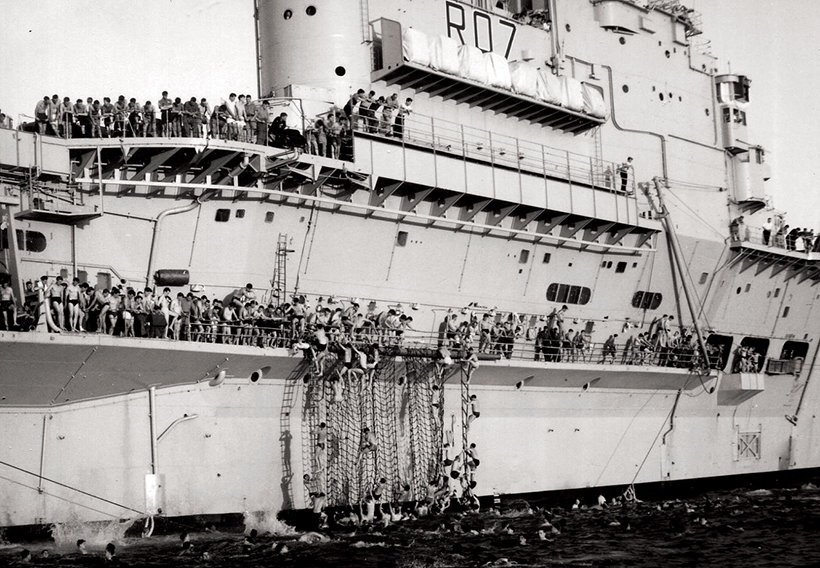
Some of Albion’s crew enjoying a spot of sea bathing.
This was the start of what was to be a major commitment for the remainder of Albion’s commission. A small force of Royal Marines and Gurkhas was flown to Brunei, but it became clear that more than two companies of troops would be required to quell the rebellion. Meanwhile, Albion steamed hard across the Indian Ocean for four days and, on Thursday 13th December, the weather-beaten ship secured alongside Singapore Naval Base.
Her stay was brief, just long enough to refuel and embark another commando brigade, before she left for the coast of Borneo. At 07:30 on Friday 14th December, just five days after receiving the first signal from Singapore, Albion anchored off Kuching, where she disembarked 40 Commando and HQ 3 Commando Brigade, who took up positions along the border with Indonesia.
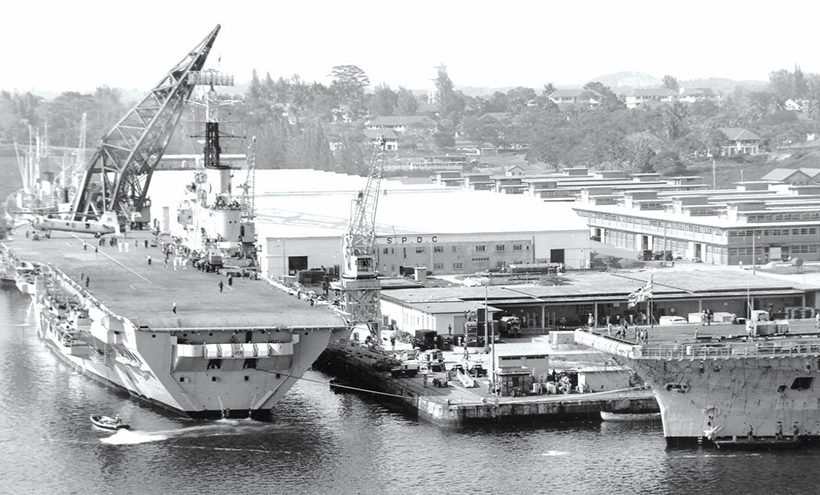
Albion berthed in the Stores Basin of Singapore Naval Dockyard; Ark Royal is in the foreground.
On duty in Brunei
The following day she anchored off Seria, and 846 Squadron were disembarked to the airport, where Albion’s Captain Madden had authorised the Army to use the helicopters as required. But, within a week of Albion’s arrival the Brunei rebellion was over. Michael Axford, of 846 Squadron, remembers: ‘While en route to Brunei, our naval whites were replaced with jungle green uniforms and rifle firing and helicopter exercises were carried out regularly. This brought home to us that it was the ‘real thing’ and drill which had been practised at Culdrose soon became an everyday event.
‘Once off Brunei, the commandos were sent to secure the airfield and once this was done we ground crews went in. We pitched our tents in what was to become ‘home’ for many months, and we had to dig monsoon ditches, which was hot work in the steaming humid rainforest. During our stay in Brunei we worked hard flying troops and equipment deep into the thick jungles – we could carry them in hours distances which would have taken them weeks hacking through the forests on foot. We relied heavily on Albion for major spares.’
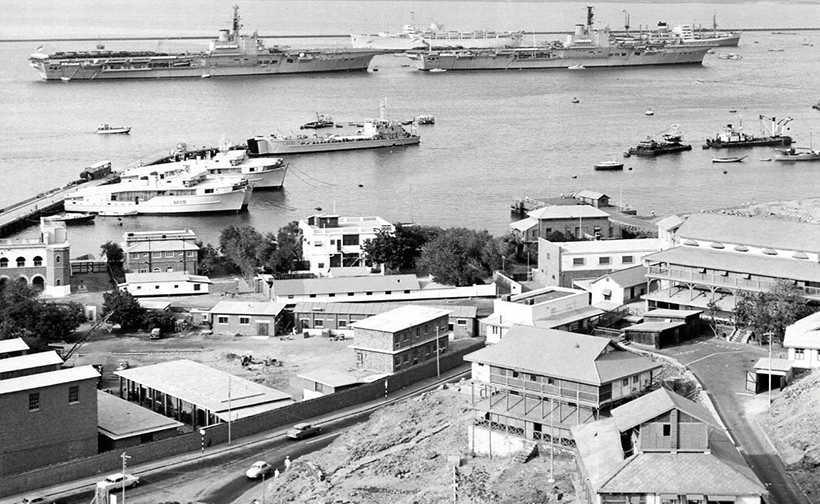
HMS Albion and HMS Bulwark together in Aden harbour.
Albion spent Christmas and the New Year of 1962-’63 patrolling the coast of Brunei, with long periods spent at assault stations, and always prepared for the next ‘lift’. Casualties were embarked, and the ship’s four LCAs almost knew their own way up the Brunei River to Brunei Town.
Prisoners were also embarked, and during the 26 days following her arrival off Borneo Albion’s helicopters flew almost 1,200 sorties in support of A Company, 40 Cdo, at Danau. It was Albion’s frequent appearances off the coast of Borneo, usually before dawn, when, in the early morning sea mists, to those watching from the shore the ship took on a ghostly phantom-like appearance, and she quickly became known as, ‘The Old Grey Ghost of the Borneo Coast’.
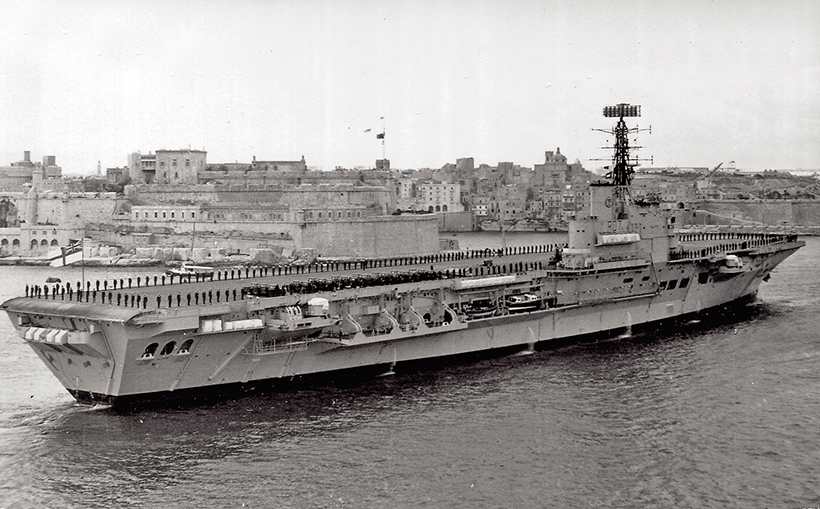
HMS Albion arriving at Valletta, Malta, in 1964, while she was homeward bound. (Pic: Mike Cassar)
Off to Hong Kong
On the morning of 8 January 1963, some 25 days after her first arrival, Albion left Brunei Bay to undertake a 26-day maintenance period at Singapore, but no sooner was this completed than the ship resumed her trooping role, this time carrying Army units in the form of the 1/7 Gurkha Rifles and the King’s Own Yorkshire Light Infantry (KOYLI) to Borneo, on the return carrying the 1/2 Gurkha Rifles and the Queen’s Own Highlanders. After disembarking the troops in Singapore, Albion sailed for Hong Kong, where, in the last week of February 1963, she tied up alongside the Naval Dockyard.
Hong Kong provided light relief, but by mid-March Albion was once again off the coast of Borneo and, to the delight of the Flight Deck Officer, the ship took on the role of a fixed-wing carrier, albeit in a very limited way. With their low landing speeds and short take-off runs, the Army’s Austers found Albion made an excellent airport and, for some weeks, one could hear the FDO and his staff muttering ‘just like the old days’, as Austers and Beavers, and even the RAF’s Pioneers, landed and took off from the flight deck.
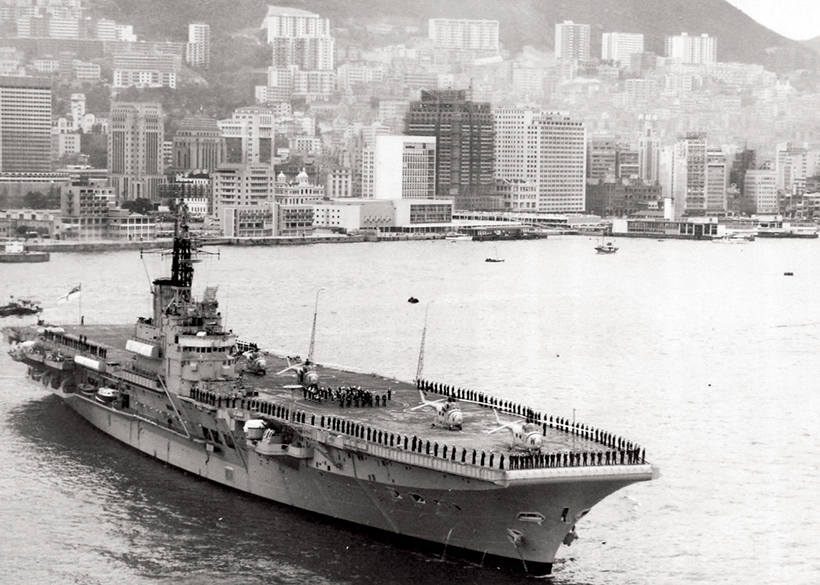
HMS Albion departing Hong Kong in early 1963.
The Far East Fleet
In early April Albion was able to join what was, in those days, the Far East Fleet, for joint exercises with the frigates Blackpool and Brighton, and the destroyer Cavendish, off the east coast of Malaya. This was only a temporary break, because on 20 January 1963 the Indonesian Government announced a policy of ‘Confrontation’ with the forthcoming creation of Malaysia, and Indonesian ‘volunteers’ began to infiltrate across the border into Sabah and Sarawak. This new tension kept Albion trooping between Singapore and Borneo right through until the end of July, with only a short four-day break at Penang.
At the end of July, for the only time during the commission, Albion joined the full Far East Fleet for a 12-day exercise, FOTEX 63, off Malaya’s east coast. This was the first opportunity for Albion to show what she was capable of, and it was not long before she had to do that when the cruiser Lion, flying the flag of FO2 FES, suffered serious boiler room problems and had to return to Singapore, and FO2 transferred his flag to Albion. Next to go down with machinery troubles was Ark Royal, and with her withdrawal from the exercise the C-in-C FES hoisted his flag in Albion.
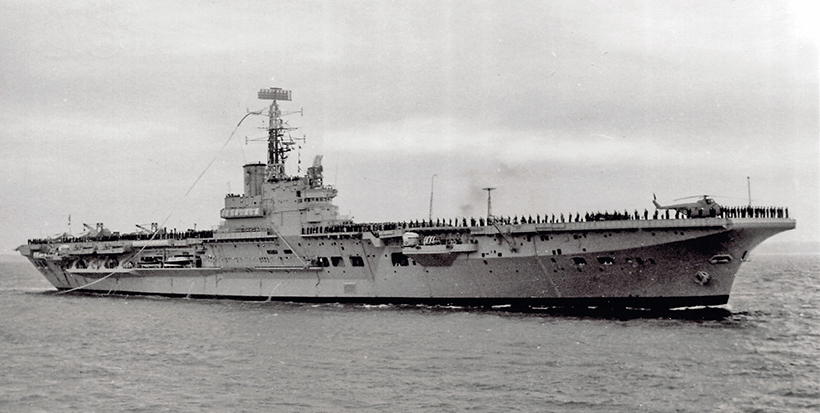
HMS Albion returning home in April 1964, arriving at Spithead at the end of her eventful commission on the Far East Station, during which she earned the moniker ‘Old Grey Ghost’. (Pic: Adrian Vicary)
With the exercise over, Albion returned to the Borneo coast, where, apart from a nine-day self-maintenance period at Hong Kong, she alternated between Singapore and Borneo, reinforcing her reputation as ‘The Old Grey Ghost of the Borneo Coast’. In late October 1963 it was decided to reinforce the RAF’s helicopter force in the Far East with additional Whirlwind and Belvedere machines, which had been flown from the UK to Tobruk in Libya.
From there the fastest way to get them to Singapore was by sea, and Albion was ordered to the North African coast, where they could be flown on board and transported east. On 1st November Albion made her northbound passage of the Suez Canal, and two days later she embarked the machines and steamed east once again. On 20th November she was back in Singapore, where the helicopters were disembarked. The round voyage of 11,000 miles had been made in 32 days, and again it demonstrated the versatility of the commando ship.
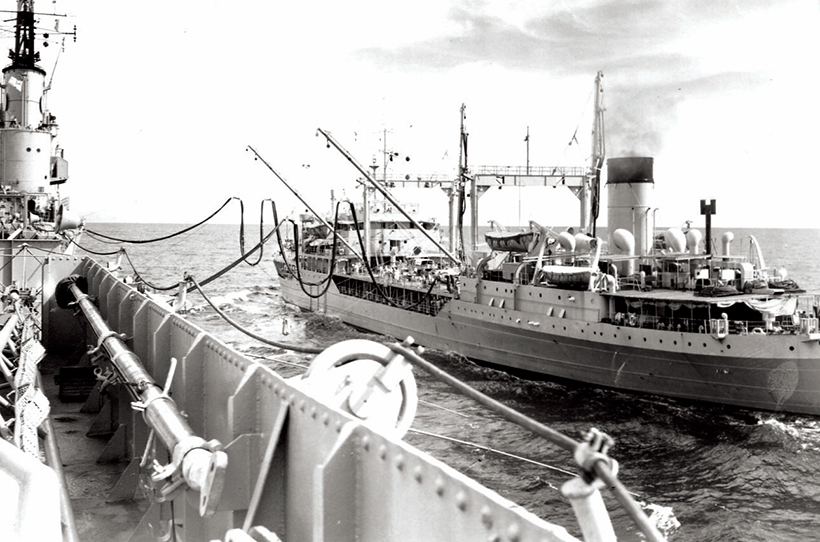
Replenishment at sea, in the Indian Ocean.
In early February 1964, however, there were problems in two former British East African colonies, with mutinies in the armies of Tanzania and the newly independent Kenya, and British assistance was requested. Although both Centaur and Victorious were in the Middle East, with the former acting as commando ship, taking 41 Cdo from Aden to Dar es Salaam, Albion’s assistance was also required.
Heading to Mombasa
On 2nd February she left Singapore and, leaving her two squadrons behind in Borneo, steamed across the Indian Ocean to Mombasa, where she arrived on 9th February. She immediately began embarking 45 Cdo, units of 16/5 Lancers and the Whirlwind helicopters of 814 Squadron, as well as two Belvedere helicopters from Victorious.
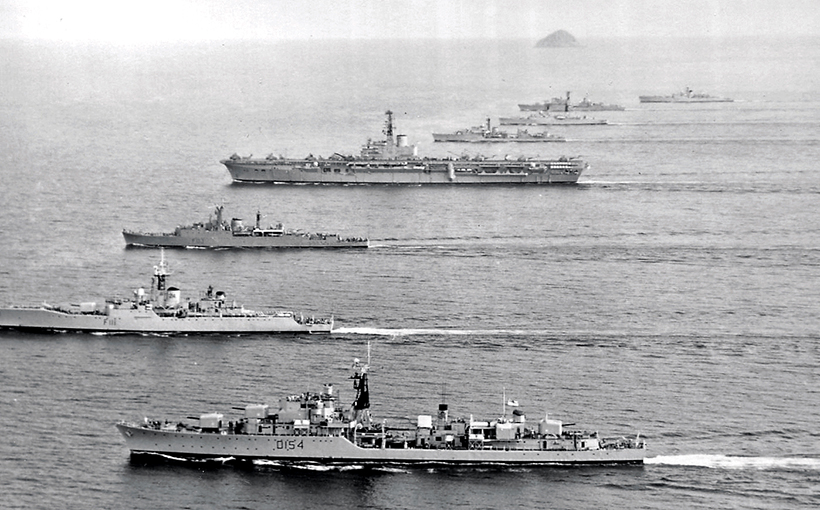
Warships line up during FOTEX 63 in the South China Seas: HMS Duchess nearest, then HMNZS Otago,
HMAS Quiberon, HMS Albion, HMS Cambrian, HMS Salisbury, HMAS Vendetta and HMS Plymouth.
Albion was back in her commando ship role, ready to land and support a fighting force at short notice. Next afternoon, with the embarkation completed, Albion left Kilindini Harbour, and it was thought that the commandos would be landed and in action soon afterwards.
Fortunately, there was an easing of the unrest in the former East African colonies, and after five days Albion returned to Mombasa, where 814 Squadron rejoined Victorious. By the end of February, 45 Cdo had returned to Aden, while Albion remained at Mombasa, and on 18th March the ship left Mombasa for Aden to rendezvous with Bulwark to transfer stores and equipment, leaving Bulwark to head for Singapore, while on 28th March Albion left Aden for Suez – and home.
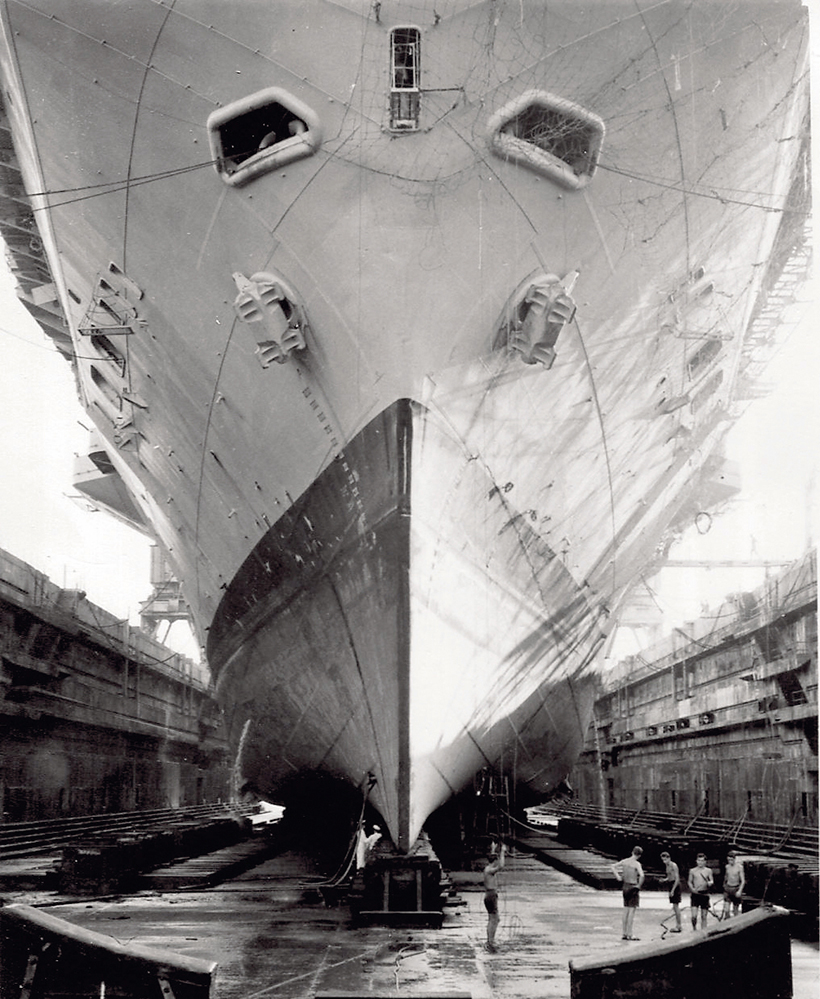
HMS Albion in dry dock at Singapore.
After calls at Malta and Gibraltar, Albion arrived in Plymouth Sound on the morning of 14th April 1964, and that evening she steamed up Channel for Portsmouth, anchoring at Spithead at 07:00 the next day. For most of the morning dockyard tenders ferried hundreds of families out to the ship, and the CO of 846 Squadron was presented with the Boyd Trophy, for the squadron’s contribution to naval aviation.
At 14:25 the pilot boarded the ship at Spithead and, just over half an hour later, Albion secured alongside South Railway Jetty. It was the end of the commission, during which she had steamed 85,000 miles, carrying 12,000 troops from a variety of regiments, and her helicopters had made more than 10,000 operational sorties. The ship’s company was broken up as the main leave parties left the ship for good. It had been a memorable commission and, for the remainder of her career Albion would be known as the ‘Old Grey Ghost’
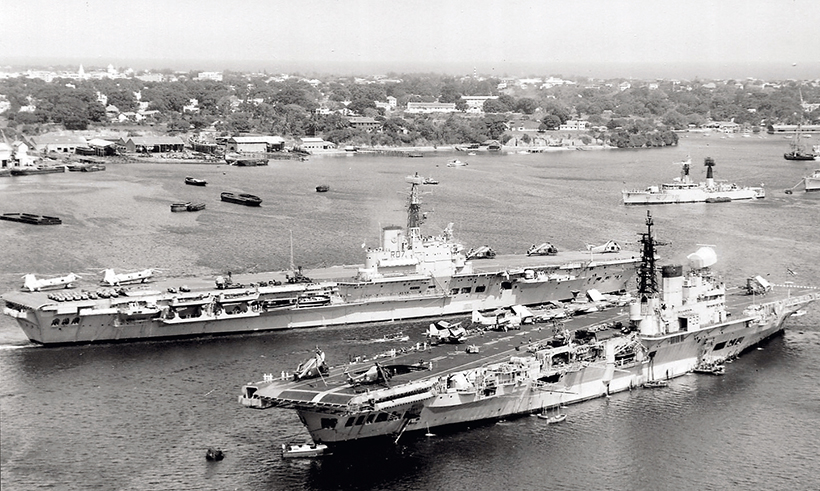
HMS Albion leaving Mombasa’s Kilindini Harbour, passing the aircraft carrier HMS Victorious.
This feature comes from the latest issue of Ships Monthly, and you cab get a money-saving subscription to this magazine simply by clicking HERE



